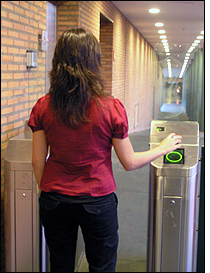Apr 18, 2007At La Finca Reebok Sports Club in Madrid, members use radio frequency identification to gain entry to the club, as well as to access facilities and amenities and pay for goods and services.
The 6,000-member club includes tennis, paddleball and basketball courts, swimming pools, hydrotherapy, a children's section and a cafeteria. All members now carry a card, bracelet or watch with an embedded 13.56 passive RFID tag complying with the ISO 15693 or ISO 14443 standard. Since installing the RFID system two years ago, La Finca has seen a savings of €70,000 ($95,000) annually due to memberships being updated more regularly (the system catches expired memberships when those members try to access the club), and to payments for goods and services inside the club being easier to make.
Provided by Legic Identsystems, the RFID-enabled cards, watches and bracelets admit members into the club, and to certain sections within the compound. The compound has four RFID-enabled access turnstiles or gates, one for the 10 tennis courts, one for underground parking and one each at the male and female locker rooms. There are also RFID-enabled locks installed at doorways and lockers.
Legic interrogators at the turnstiles capture a cardholder's access rights, as do other readers situated at the doors to the locker rooms, parking lot, sauna, spa and tanning booth. "If a member did not book the spa or the sun cabin [tanning booth], for example," says Marcel Brand, Legic manager of marketing, "he also has no access to these areas." Data is stored in Reebok's back-end management system.
Most of the interrogators are wired to the back-end system. Doorway RFID readers, such as those at locker rooms, can be run as an offline reader that stores each member's access rights. RFID integration at doors, as well as data integration to the club's back-end system, is managed by LEGIC partner Gantner Technologies.
Because of the size of the club and the number of members, La Finca has had a problem controlling individuals' movements throughout the compound and ensuring memberships are up-to-date. One example involved the tennis courts. Before the Legic system was installed, patrons would crowd the courts while waiting to play, with no control regarding who used the courts and when. With the RFID system, members can now pass through the court's RFID-enabled turnstile only when a court is available, and only if their card ID number proves they are, in fact, fully paid members. The turnstiles allow La Finca to regulate how many people are on the courts, and to refuse access to additional players until someone leaves.
Members can use their RFID-enabled cards, watches and bracelets to obtain a locker by presenting the card to a specific locker's RFID reader. A locker will open only if the card's ID number is authorized. Members will eventually be able to use their IDs to pay for food and drinks at vending machines, and to use the sun-tanning booth. Later this year, the club also expects to allow members to use their IDs to pay for meals at the restaurant, where POS RFID interrogators will likely be set up at the cashiers desk and employees will also have mobile handheld readers.
The RFID tag embedded in a member's card, watch or bracelet holds a unique ID number, linked to the user's personal data in La Finca's back-end system. Access rights are stored in the reader device, says Brand,. "Also stored on the card is the electronic purse of each member," he says. The purse indicates how much money is left in the member's account. Members can load money into their account by inserting the desired amount of cash into a terminal and then scanning their ID. "Because of the high-security features of LEGIC," Brand says, "the data—and, therefore, the electronic money—is safely stored on the card, which is in the possession of the cardholder."
La Finca staff and customers are reportedly happy with the system, which has been continually expanded since its installation in 2004. "The comfort with the bracelet is very high," Brand notes. The next likely addition will be the installation of RFID-enabled vending machines, which would allow club members to use their IDs to purchase snacks and beverages.


